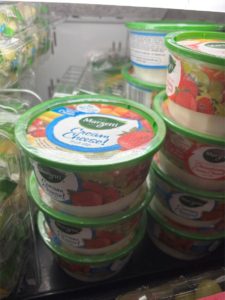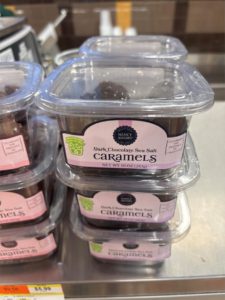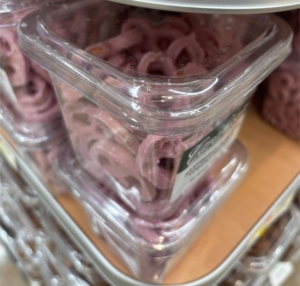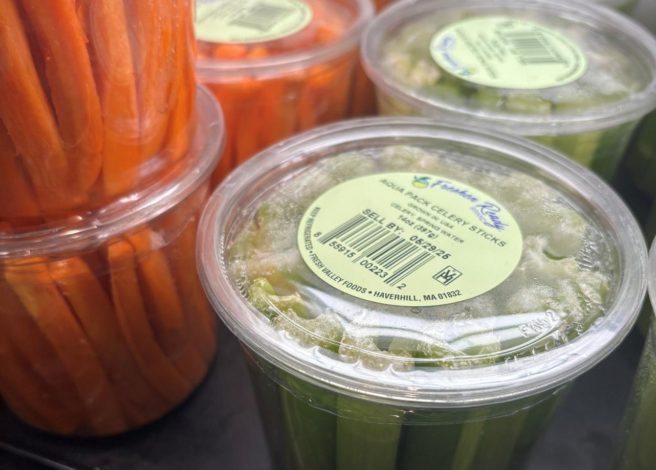At a Glance
- Shrink bands offer solid tamper protection, but come with labor, equipment, and sustainability costs.
- Use is declining as brands seek easier, greener, and more cost-effective alternatives.
- Supplier options are shrinking, making shrink bands harder and more expensive to source.
- C-wraps, labels, and built-in seals are rising as viable tamper-evident replacements.
Let’s set the scene: You’re three hours into a road trip with friends when someone realizes they forgot to pack snacks. No problem — you pull into the next convenience store to stock up on road trip essentials. Back in the car, it’s your turn to drive, and you reach for that container of chocolate-covered pretzels you just bought. You’re cruising down the highway, ready for a quick snack, when you encounter a roadblock: That stubborn plastic band wrapped around the container lid refuses to budge. This piece of plastic represents an interesting debate in the food industry today: The use of shrink bands in fresh food packaging.
If you’re a food business professional, this road trip scenario isn’t just an amusing anecdote — it’s a critical business decision playing out in real-time. You juggle product safety, shelf appeal, and consumer convenience daily. Shrink bands lie at the intersection of this packaging puzzle. The question isn’t just whether shrink bands work; it’s whether they’re helping or hurting your bottom line.
At Inline Plastics, we’ve spent over 55 years solving packaging challenges. We’ve watched trends appear, change, and sometimes fade away. Recently, we spoke with a major food processor to get the inside scoop on where shrink bands stand in today’s competitive marketplace.
We found key insights that may change how you view tamper-protected solutions. It’s time to ‘band together’ and take a closer look.
The Types of Shrink Bands
 Before discussing the controversy, let’s establish the basics. Shrink bands come in two main types, each suited to different production needs and volume requirements.
Before discussing the controversy, let’s establish the basics. Shrink bands come in two main types, each suited to different production needs and volume requirements.
Preformed shrink bands arrive pre-cut and molded to fit specific container dimensions. Imagine them as tailored suits for packaging. They match your exact needs and allow for quicker application. These bands are ideal for high-volume production lines where consistency and speed matter most.
Roll stock shrink bands, on the other hand, come in continuous rolls that require cutting to size during application. They provide more flexibility for different container sizes. However, they usually need extra processing time and equipment.
Most food processing facilities have invested in heat tunnels for preformed bands. This makes them the top choice for large operations.
How Are Shrink Bands Applied to Products?
The application process might seem straightforward but involves more complexity than meets the eye. Here’s what happens behind the scenes:
The process begins with placing the shrink band around the container’s closure area. This can be done by a person or a machine. The package then goes through a heat tunnel, where controlled temperatures shrink the plastic, creating a tight seal around the container’s edge. This heat application is precise and brief, designed to shrink the band without affecting the food product inside.
Our industry contact explains that the heat is fast and does not impact shelf life or the product. It’s just an additional step and expense in the manufacturing process.
However, this “additional step” represents both labor costs and equipment investment. Heat tunnels need upkeep, use energy, and require skilled operators. These factors can add up fast in busy production settings. It’s like having a very expensive hair dryer that only works on plastic and requires its own dedicated staff.
The Pros and Cons of Shrink Bands
The Advantages: Why Companies Still Use Them
 Shrink bands offer two primary benefits that keep them relevant in today’s packaging landscape:
Shrink bands offer two primary benefits that keep them relevant in today’s packaging landscape:
Full perimeter seal: Shrink bands wrap fully around the closure. This is better than labels or tapes covering only parts of a container.
Tamper protection: For food safety and brand protection, this level of security can be invaluable. Consumers can quickly spot if a product is compromised. Retailers can also feel safe stocking products, knowing they are protected in the supply chain. It is worth noting that the effectiveness of this tamper-evidence may be questioned because of one simple fact: If the shrink band is removed completely, there is no sign it was there in the first place. These bands help keep packages tamper-resistant. So, it’s hard to open them while the bands are still attached.
The Disadvantages: The Growing Concerns
However, the drawbacks are becoming increasingly significant:
Cost implications: Companies need to consider more than just the bands. They must consider heat tunnel equipment, energy costs, and labor for extra processing. They must also account for customization needs across different container sizes.
Consumer frustration: This is a hidden cost. It’s hard to measure, but it can cause serious harm. When customers have difficulty opening products, especially grab-and-go ones, it can affect their buying choices and loyalty to the brand. This is especially true for shrink bands without perforations. Think about it: How often have you tried breaking one of these bands with your teeth? You can admit it. There’s no shame in the packaging world!
Environmental concerns: These are becoming increasingly important. As our industry expert points out, shrink bands are considered problematic packaging and are not recyclable. Today, sustainability shapes what consumers buy and how companies act. This limitation matters.
Operational challenges: The hurdles include sizing risks with preformed bands. Different containers may also need customization. Plus, ensuring consistent application across production runs can be complex. For some packages with liquid components like pickles, shrink bands have not prevented leaking.
The Current State of Shrink Bands
 Here’s the most revealing insight from our industry conversation: when asked whether shrink bands are being used more or less frequently, the answer was definitively “less.”
Here’s the most revealing insight from our industry conversation: when asked whether shrink bands are being used more or less frequently, the answer was definitively “less.”
This trend reflects broader changes in the food packaging industry. Companies are examining the costs and issues of shrink bands. They compare these options to others that offer similar protection. However, those alternatives are more convenient and better for the environment.
The decline doesn’t mean shrink bands are disappearing entirely, but it does signal a shift in industry priorities. Food processors actively seek alternatives that balance security, cost-effectiveness, and consumer satisfaction.
The Shrinking Supplier Landscape: A Hidden Challenge
The shrink band industry is experiencing two key changes. First, food processors and retailers are using shrink bands less frequently. Second, and perhaps more importantly, the number of suppliers in the industry is shrinking. Economic pressures, changing consumer preferences, and environmental concerns are forcing manufacturers to consolidate, which reduces the variety and availability of shrink band solutions in the market.
Industry Consolidation and Supplier Challenges
The packaging sector has witnessed notable consolidations and closures. For instance, Design Group Americas (DGA), a major player in gift packaging and party supplies, filed for bankruptcy due to declining consumer spending and tariff uncertainties. Although DGA’s primary focus wasn’t shrink bands, its financial struggles reflect broader challenges in the packaging industry.
Implications for Food Businesses
This contraction means fewer options for businesses relying on shrink bands. Reduced competition can lead to higher prices, longer lead times, and limited customization. For food businesses, this underscores the importance of exploring alternative tamper-protection solutions that align with current market dynamics and consumer expectations.
What Are Other Options for Shrink Bands?
If you’re considering ditching shrink bands, there are some alternatives. These options offer tamper protection without the hassles.
C-wrap labels offer partial tamper protection while remaining seemingly easy for consumers to remove. These labels go around containers partially. They show if tampering has occurred but don’t cover the entire perimeter like shrink bands do.
Clear tamper-evident labels provide security indication while maintaining package visibility. These labels are designed to show clear evidence of tampering while being more consumer-friendly than traditional shrink bands.
Tamper tape represents another option for specific applications. While unsuitable for all container types, tamper tape can provide security indication. This tape doesn’t offer as much tamper resistance as other solutions, as it’s easily removable, but does provide tamper evidence as a special residue, usually with text stating “opened,” from the tape left behind.
Tamper-protected packaging incorporates specialized technologies and security systems directly into the package design.
Each option has costs and benefits. The best choice depends on your product requirements, production capabilities, and consumer expectations
Making the Right Decision for Your Brand
 The future of shrink bands isn’t about whether they work — they do provide tamper protection. The question is whether they align with your brand’s priorities and customers’ expectations.
The future of shrink bands isn’t about whether they work — they do provide tamper protection. The question is whether they align with your brand’s priorities and customers’ expectations.
Consider your product’s use case: Is it a grab-and-go item where convenience matters most? Are you targeting environmentally conscious consumers? Does your product require maximum security, or would moderate tamper protection suffice? (Spoiler alert: “Moderate” tamper protection doesn’t work as well as packaging with clear tamper-evident and tamper-resistant features).
The Great Shrink
The conversation around shrink bands reflects a larger shift in packaging philosophy. Today’s successful food businesses don’t just ask, “Does this packaging protect our product?” They ask, “Does this packaging enhance our customers’ experience while meeting our security and sustainability goals?”
Shrink bands aren’t vanishing quickly, but they are clearly ‘shrinking away’ from their stronghold in food packaging. Consumer frustration, environmental concerns, and rising costs are creating a demand for new, easy-to-use options.
The declining use of shrink bands doesn’t make them wrong for every application, but it does make exploring alternatives about as smart as packing snacks before a road trip.
Ready to explore your packaging options? The conversation begins by identifying your priorities. Then, it leads to solutions that benefit your business and meet your customers’ needs. The shrink band conversation is no longer just about safety — it’s about strategy.
Want to learn more about tamper protection in fresh food packaging? Visit our Learning Center today!

